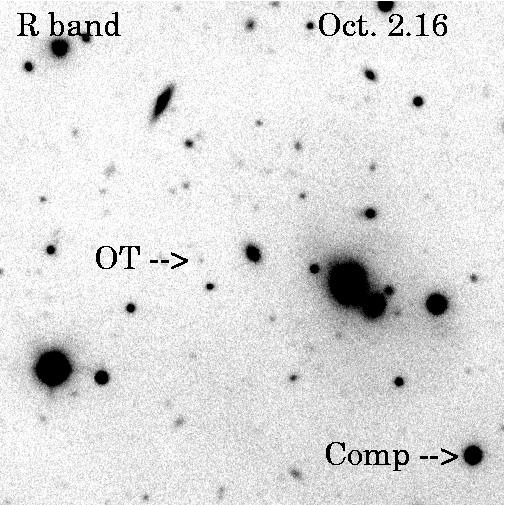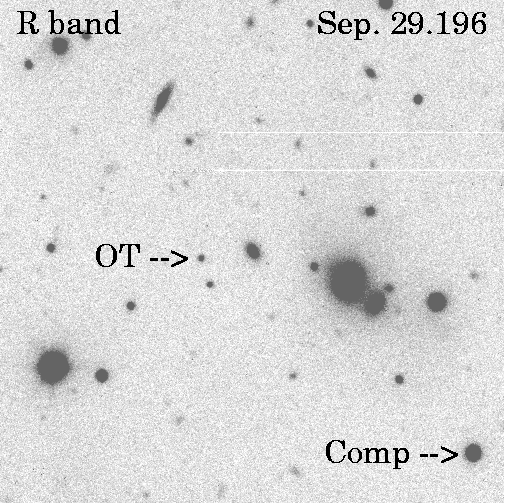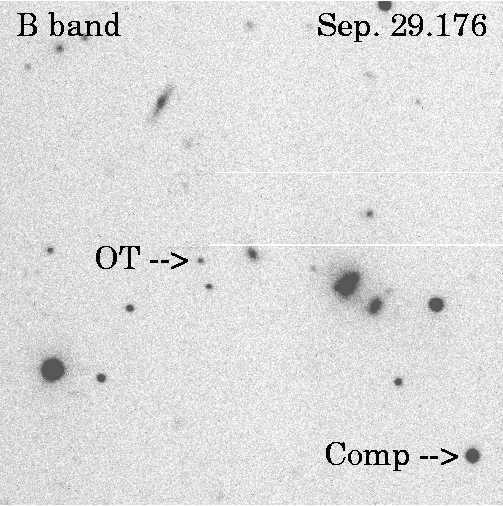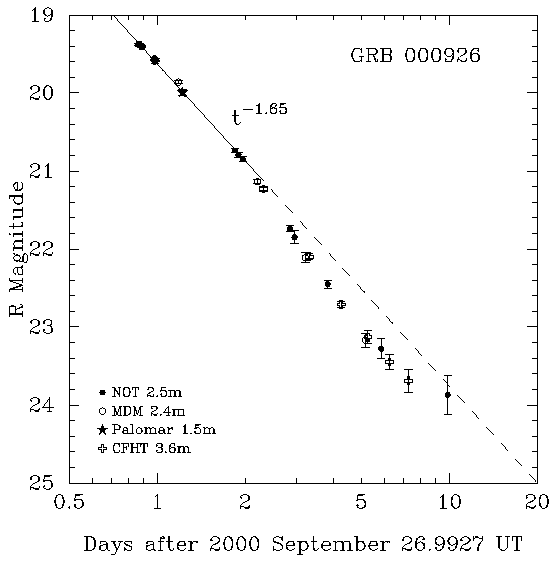|
|
GRB 000926 Optical Afterglow
MDM 2.4m (2.3x2.3 arcmin display)
 |
 |
 |
| GCN Circular #829: GRB 000926 Optical Decay |
J. P. Halpern, N. Mirabal (Columbia U.), D. Turnshek & J. Busche (U. Pittsburgh) report on behalf of the MDM Observatory GRB follow-up team: "Using the MDM 2.4m, we obtained 5x900 s exposures in the R band centered on Oct. 2.16 UT. Using the comparison star previously measured at R = 17.06 (GCN #824), we find for the OT R = 23.17 +/- 0.09 (1 sigma). This is significantly fainter than the measurement made by Veillet just after ours (GCN #827, R = 22.82 +/- 0.08 on Oct. 2.26), which constitutes an interesting discrepancy. Our own measurement is consistent with a constant decay slope alpha = -2.23 +/- 0.07 after day 2, and would predict that R = 23.9 +/- 0.1 on Oct. 4.0 UT. This image and an updated decay curve are posted at http://www.astro.columbia.edu/~jules/grb/000926 This message may be cited." |
| GCN Circular #824: GRB 000926 Optical Observations |
J. P. Halpern, N. Mirabal (Columbia U.), D. Turnshek
& J. Busche (U. Pittsburgh) report on behalf of the
MDM Observatory GRB follow-up team:
"We processed and calibrated the MDM R and B data reported
previously in GCN #806, now using Landolt standard stars,
and we acquired new R and B observations on the MDM 2.4.
The comparison star at (J2000) RA 17:04:01.21, Dec +51:46:19.9,
previously assumed to have R = 17.1, is now measured at
R = 17.06, B = 18.50. In this new system, we find the
following magnitudes for the OT:
Sep. 28.183 B = 20.89 +/- 0.04
Sep. 28.177 R = 19.86 +/- 0.02
Sep. 29.176 B = 22.11 +/- 0.09
Sep. 29.196 R = 21.14 +/- 0.03
Sep. 30.179 B = 23.07 +/- 0.06
Sep. 30.211 R = 22.11 +/- 0.06
Correcting the observed B-R for the Galactic extinction
A_B = 0.101, A_R = 0.063 of Schlegel et al., we find that
B-R = 0.95 +/- 0.05 consistently for these three nights.
This color corresponds to spectral slope beta = -1.51 +/- 0.12,
which indicates that there may be intrinsic extinction.
Our latest R-band measurement confirms the steepening of the
decay reported by Fynbo et al. (GCN #820) and Veillet (GCN #823)
For the first 2 days the decay slope was consistent with
alpha = -1.65 +/- 0.02. After 2.2 days, alpha = -2.51 +/- 0.17.
Images of this field and an updated decay curve are posted at
http://www.astro.columbia.edu/~jules/grb/000926
This message may be cited."
|
| GCN Circular #806: GRB 000926 Optical Observation |
J. P. Halpern, N. Mirabal (Columbia U.), D. Turnshek & J. Busche (U. Pittsburgh) report on behalf of the MDM Observatory GRB follow-up team: "We observed the optical candidate for GRB 000926 (Gorosabel et al. GCN #803; Dall et al. GCN #804) in R and B on Sep. 28.177 UT using the MDM 2.4m. We measure the position of the optical candidate to be (J2000) RA 17:04:09.749, Dec +51:47:09.97 in the Guide Star Catalog system, relative to eight stars having an rms dispersion of 0".15. A preliminary magnitude for the optical candidate is measured as R = 19.89 +/- 0.02, referenced to a USNO-A2.0 star at (J2000) RA 17:04:01.206, Dec +51:46:19.88 which is listed as having R = 17.1. Since this measurement was made from an unprocessed image, it is subject to additional systematic error, and should not be used in serious analyses. The decay rate is therefore still unknown." |
| The following figure will be updated whenever more recent measurements become available. Click here to receive the latest postscript version. |
 |
|
Jules Halpern jules@astro.columbia.edu | |
|
Columbia University Astronomy
and Astrophysics, and MDM Observatory | |
